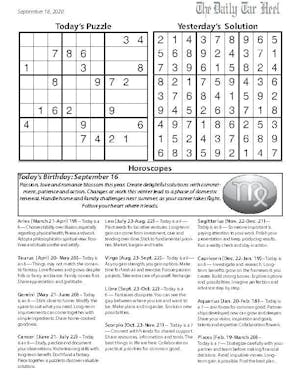“Differentiate,” an exhibit in the Allcott Gallery of the Hanes Art Center, features the works of Gina Osterloh and Mores McWreath.
It challenged my ability to distinguish between perception and reality — all the while beckoning the question, “Where does the optical illusion stop and the art begin?”
Utilizing mixed media and photography, the two featured artists create a dialogue about true identity and the identity forced on us by a label-happy society.
Gina Osterloh
The Los Angeles-based Osterloh recently studied surrealism and contemporary art in the Philippines on a Fulbright Grant. She incorporates her experiences there into her pieces.
Focusing on the human body, Osterloh uses an array of patterned backdrops to distract from the body in question.
In her photo “Blind Rash,” the pink paper lining the walls made me feel uncomfortable in its eerie similarity to a padded cell. The human subject, who dons an eye patch and curls up in the middle of the room, appears to be grasping the floor in search of something.
The exhibit led me to a startling question: How do you define “identity” in something that you can’t see?
Just as the photos in the “Differentiate” exhibit cannot be judged at first glance, Osterloh’s work reminded me that nothing, in art or in life, can be understood from first impressions alone.
Mores McWreath
In contrast, McWreath, who currently teaches at The Cooper Union for the Advancement of Science and Art, emphasizes the theme of identity with far less subtlety.
His repeated use of manufactured goods in his pieces draws parallels to society’s manufacture of identities.
One of his photos features processed foods: white bread, crackers, raw cookie dough, hash browns and other American carbohydrate staples.
The photo is analogous to the white bread culture of America, made me feel nauseated. This feeling resulted from the unpleasant confrontation with McWreath’s message — identity is easily lost in something as revoltingly simple as the food we eat.
“Same Flight,” a multi-media piece running 15 minutes long, loops images of junkyards, suburbs, farmlands and forests in a body-shaped cutout topped with a seemingly disembodied head.
Between the moving limbs of the body and the flashing images, the audio of the voice on the video almost gets lost.
But once past the visual assault, the piece declares that interpretation of identity, whether of a piece of art or of a human being, is easily lost in our daily barrage of sensory overload.
“Differentiate” is open in the Allcott Gallery of the Hanes Art Center until tomorrow. Get there while you still can!
To get the day's news and headlines in your inbox each morning, sign up for our email newsletters.




